 |
| |
What would you like to see on this site?
 let us know let us know
|
 |
|
|
|
|
| Modelling - Locomotives |
| |
Why?
There is now a large range of good quality ready-to-run locomotives in 'OO' scale, so it would be easy to buy some and leave it at that, but anyone can do that, so why not try to create something unique that no one else has? Even if others have a model of exactly the same locomotive, yours will be unique as you have created it. Furthermore, far more locomotive types and variants, whether steam, diesel, electric or gas turbine were built than have been produced as ready-to-run models, giving the modeller the opportunity to create something unusual. I am particularly fond of creating models of locomotive designs, especially diesels, that are long-since scrapped, often known as 'dinosaur diesels', many of which are not available even in kit form, but can be created by modifying existing ready-to-run models or building kits.
Why Do You Use Hornby-Style Couplings?
You will notice from many of the photographs of my model locomotives that I still use the standard Hornby-style tension-lock couplings, sometimes known as 'bow and arrow couplings' or 'snowploughs'. They consist of a horizontal loop and a vertical hook, allowing two items of rolling stock to be relatively securely attached together by both hooks, enabling easy uncoupling by pushing both hooks up and easy coupling by simply pushing the two items together. A further benefit is that when trains are pushed around tight curves, the items of rolling stock bear on each other through the loops, thereby avoiding the buffers on adjoining vehicles locking together to cause a derailment.
There are alternative designs of couplings, many of which are smaller and less conspicuous, and in the case of three-link, screw and American-style buckeye couplings, almost scale, but none are as reliable, freely available, or as easy to use as those supplied by Hornby (previous style), Lima (now taken over by Hornby), Airfix (wider style) and to a lesser extent Mainline, all of which are relatively interchangeable.
Ideally, all modellers would use screw, three-link or buckeye couplings as appropriate to the individual item of rolling stock, but even these couplings are over-scale and not always practical when trying to run long trains reliably at exhibitions.
Having said all the above, some selected locomotives of mine do have less conspicuous couplings that still work with standard ones, but are soldered up from nickel silver handrail wire and one or two locomotives have no working couplings at all at one end if they are always run the same way round.
If you still think that three-link is the only way to go, try coupling up several trains of forty wagons on our club's 'Cherwell Junction' layout and changing them over once or twice on an exhibition day.
How Do I Get Started?
The obvious answer to this is by trying something cheap and simple first, a step at a time, and moving to more complex projects when your experience and skill levels improve. One of my suggestions would be a BR class 25/1 or early-bodied class 25/2, based on a second hand Hornby model, similar to my own 25-057 or D7577. The locomotive will cost 20 to 25 pounds at a toyfair or swapmeet and can even have damaged paintwork as it will be repainted. The improvements required for a good model are quite small and it is entirely up to you how much or how little work you do. Make sure you get at least one photograph showing all body and chassis details of the exact locomotive you want to model and within no more than a few years of the condition you want to model it in, but beware that the bodies and chassis of locomotives often look different on each side of the same vehicle and are usually 'handed'. If you follow the source evidence precisely, no one can say you have got it wrong.
I'm not a Scientist Called Brian or a Rocket Surgeon - is it Difficult?
No, it is not difficult at all if you are experienced in other fields of craft or model-making, or at least have a steady hand, take advice from more experienced modellers, plan what you will do and take each step in a logical order. The most important sequence to be adhered to is to do the heaviest work first, then finer details, then painting and finally fitting transfers. In this way, the most fragile parts will not be damaged by doing heavy work last.
What if I Mess it Up?
You will undoubtedly have a few mishaps while modelling - I still have minor ones regularly after about thirty years' modelling experience. Most mishaps can be easily put right with delicate use of scalpel, glue, filler or paint. Major disasters caused by things like one layer of paint attacking another can also be rectified, but you may have to use paint stripper or car brake fluid to remove any affected paint. Test an inconspicuous area before using either of these as they can melt plastic, or at least soften it. Complete disasters may have to be chalked down to experience - at least you probably will not do it again - and you now have more spare parts for future projects. This is why early experiments should only be performed on easily affordable subjects.
But Aren't All Diesels the Same?
Where do I begin with this one? The physical form of any enclosed machine will tend to be a box of smallest convenient dimensions. On a steam locomotive this is usually a horizontal cylinder containing the boiler and allowing easy access to this maintenance-hungry part of the machine, a box for a cab and boxes to hold the coal and water. Diesels and electrics are slightly different in that they may have lots of electric and later electronic machinery that needs to be sheltered from the elements. All but the smallest diesels and electrics tend to have a cab at each end also. This means that most diesels and electrics consist of a basic box shape, unlike most steam locomotives, and one dirty blue or green box will tend to look a lot like another at first glance, however this is not the case if you take the trouble to look a bit closer. A good example of this is the 327 BR class 25 diesels. Within the same sized box there is an almost identical machine, but with widely varying external details - more differences in fact than in, for example, the fleet of 330 GWR Hall class steam locomotives designed for a similar, mixed traffic role.
Apart from physical appearance, diesels and electrics were built by a wide range of manufacturers and with a wide range of engines, electrical equipment, transmissions, wheel arrangements and to different structural designs. A vast array of liveries has been worn by the fleet as well and many locomotives have been modified for special roles or as changing traffic requirements dictate.
It also might help to put it into perspective for steam enthusiasts that the last steam locomotive built for BR was 2-10-0 number 92220 'Evening Star', which was built at Swindon Works in 1960, later than some of the diesel classes I have modelled were introduced and a few years after the first BR 'first generation' passenger multiple units and 'pilot scheme' diesel locomotives were introduced.
Diesels and electrics are normally dismissed as 'modern image', but all the 'Big Four' railways had at least some examples before they were nationalised into BR on 1st January 1948, over 60 years ago as I write this. Modern image? Some of the diesel locomotives I have modelled were also withdrawn before the official end of BR steam in 1968 and that was 40 years ago. Do not dismiss the last forty years out of hand. Any good 1960s layout, and some set in earlier periods, should have both steam and diesel and some may have electric rolling stock as well, especially if it is a Southern Railway or Southern Region layout.
|
| |
Loco Descriptions - Steam |
| |
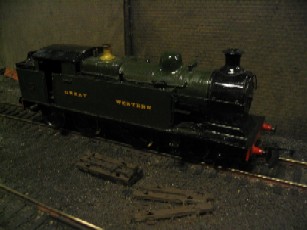
|
|
Rhymney Railway R1 class 0-6-2T No. 39 in GWR green livery with original boiler.
The Model
This locomotive has a scratchbuilt Plastikard body on a Mainline 5600 class 0-6-2T chassis which is almost exactly the same dimensions as the R1 chassis. Various metal fittings are used, such as whistles, safety dome, chimney, tank overflows, tank fillers and buffers. Ten wire handrails are fitted. The water feed pipes on top of the boiler are made from plastic rod. The sandboxes on the chassis were covered with Plastikard to mimic those on the prototype and the radial truck spring is stiffened to reduce derailments, which are a problem on unmodified examples of this chassis. Hornby couplings are fitted, but the rear one has no hook as this too seemed to cause derailments on curves due to the long overhang at the rear of the locomotive. Etched brass numberplates are fitted. This is an old model in need of some minor improvements and a repaint.
Back to Top
|
| |
The R1s
Ten class R1 locomotives were delivered to the Rhymney Railway in 1921. Most RR locomotives were 0-6-2Ts and their main usage was on unfitted coal trains in South Wales. After the railway was absorbed into the Great Western Railway at The Grouping in 1923, some locomotives were rebuilt with GWR boilers and fittings. None are preserved, but Taff Vale Railway 0-6-2Ts numbers 85 and 28, GWR numbers 426 and 450 are preserved.
39
39 was delivered from Beyer Peacock as Rhymney Railway number 43 in December 1921. It was rebuilt with a GWR standard number two boiler in May 1930 and withdrawn in August 1955. |
| |
|
|
|
| |
Loco Descriptions - Diesel |
| |
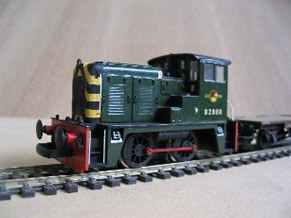
Photo is PRotDS Pl.109 and 112.
|
|
Class 02 / D2850 - D2869 - Yorkshire Engine Company / Rolls Royce 170hp 0-4-0 Diesel Hydraulic Shunter No. D2860 in original green livery with yellow and black 'wasp' striped ends. A DJH 'beginners' kit. Mostly white metal with a few etched brass fittings and of soldered construction. A very easy kit to build. This model has 22 wire handrails fitted in addition to the main etched cab handrail that comes with the kit and the stripes are hand painted. Glazing is Microscale 'Micro Kristal Klear'. The model is wired in reverse to the instructions to stop it running backwards. Paint is Howes' and Humbrol and transfers are P.C. Pressfix. The class 02s were introduced in 1960 and were built to replace short wheelbase steam locomotives such as the Lancashire & Yorkshire Railway 'Pug' 0-4-0 STs, particularly in the Merseyside area. This locomotive was withdrawn in 1970, before it gained an '02-' TOPS number, and is preserved at the National Railway Museum, York.
Back to Top
|
| |
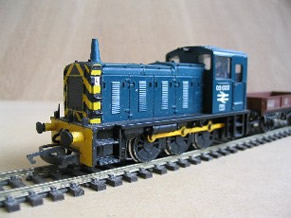
Photo is PRotDS Pl.57.
|
|
Class 03 / D2000 - D2199, D2370 - D2399 - BR / Gardner 204hp 0-6-0 Diesel Mechanical Shunter No. 03-022 in BR blue livery with black and yellow 'wasp' ends from a photograph taken on the 20th April 1979. A detailed Mainline model. Nine additional wire handrails are fitted. Turned brass double horns and a conical exhaust from J & M products are fitted. The safety screens behind the cab steps have fine square mesh, available in various grades for winemakers at Boots, at a 45 degree angle fitted to their rears. Most of the original paintwork is retained, except for some Howes Railmatch and Humbrol. Transfers are PC 'Pressfix'. The class 03s were introduced in 1957, based on the earlier class 04s, as the standard BR small shunter. The conical exhaust stack on this locomotive applies to only early locomotives as it was later found necessary to weigh down the front ends of these machines with a heavy cast iron 'plant pot' shaped chimney surround. This locomotive requires weathering. Back to Top
|
| |
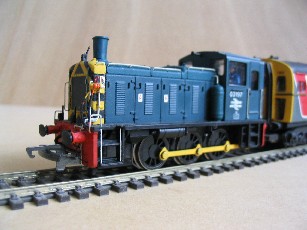
Photo is PRotDS Pl.56.
|
|
Class 03 / D2000 - D2199, D2370 - D2399 - BR / Gardner 204hp 0-6-0 Diesel Mechanical Shunter No. 03-197 in BR blue livery with black and yellow 'wasp' ends from a photograph taken on the 27th August 1979 and from photographs taken by me at Leicester Depot on 13th January and 27th April 1989. A detailed Bachmann model, converted to dual air and vacuum brakes. Southern Region high level brake pipes and 15 wire handrails are fitted in addition to the shortened standard cab rear handrail. The air tanks are by J & M Products and the compressor cupboard is scratchbuilt from plastikard. The original paint finish is mostly retained. Brake pipes, hoses and fittings are made from handrail wire and knobs. Stays for the brake pipes are from very thin wire. The safety screens behind the cab steps are fitted with fine mesh. Additions are painted with Howes Railmatch and Humbrol paints. The prototype for this locomotive was delivered in 1961 from BR Swindon Works. The Southern Region modified various classes of locomotive to have high level brake pipes, allowing them to be coupled to multiple units from platform level, rather than risking going near the live third rail. Back to Top
|
| |
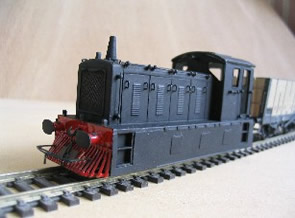
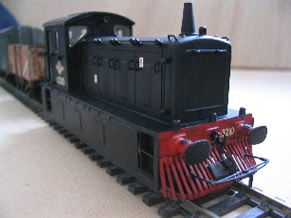
|
|
Class 04 / D2200 - D2341 - Drewry / Gardner 204hp 0-6-0 Diesel Mechanical Shunter No. D2210 in BR black livery with tramway skirts and cowcatchers, circa early 1960s. This model has 'spare' Vulcan whitemetal 'early' cabsides, 'clipped' oval buffers and etched brass skirts and cowcatchers. The chassis is by Bachmann and is a very tight fit, requiring some of the bonnet-top handrail knobs to be cut back. A J & M Products turned brass conical exhaust and horn are fitted. All other parts are from the Airfix / Dapol plastic kit. 37 wire handrails are fitted. The tension-lock style couplings are soldered together from nickel silver wire. Steps are scratchbuilt from plastikard. Paint is by Humbrol, with the 'D' on each bufferbeam handpainted in Howes' GWR coach cream. The Vulcan parts are not an easy fit onto the Airfix ones as the Airfix model is shorter than the Vulcan. The recesses in the Airfix running plate have been filled with plastikard and the cab front windows lowered as the kit was originally modelled on a later locomotive than D2210. The bufferbeams were given a black wash before the transfers were applied. The remaining parts of the Vulcan kit were used to build another class 04. Paint is by Humbrol and transfers are by PC Pressfix and Fox. Glazing is Microscale 'Micro Kristal Klear'. The class 04s, except for a single demonstrator delivered to the LNER in 1947, were delivered from 1952 and were based on a 1934 0-4-0 diesel supplied to the LMS. They were necessary as the large 350hp diesel electric shunters could not negotiate the tight curves found in some docks and tramways. The prototype locomotive was used, along with D2212, on the Yarmouth Quay tramway. The left hand side and rear of this locomotive is pictured with a missing skirt on TDS P.84 at Norwich Thorpe in April 1961 and the right hand side and front with a few missing skirt panels on PRotDS Pl. 72 at Yarmouth North Quay on 8th September 1962. This model is currently awaiting cab doors, train vacuum brake pipes and further weathering. Back to Top |
| |
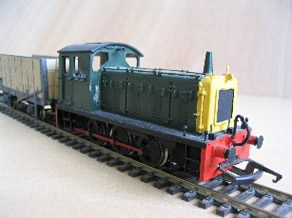
|
|
Class 04 / D2200 - D2341 - Drewry / Gardner 204hp 0-6-0 Diesel Mechanical Shunter No. D2xxx in BR green. This is the excellent Vulcan whitemetal kit, of soldered construction, possibly still available from Alan Gibson. The chassis is of soldered, folded etched brass and has an Airfix MRRC 5-pole slot car motor and Romford gears and wheels. The drive shaft cranks are cut out of the centre of the same size of Romford wheels, with a Romford axle. The tramway fittings and some other parts from this kit were used on class 04 number D2210. There are no fewer than 39 wire handrails fitted and sprung buffers. This model is currently being painted.
Back to Top
|
| |
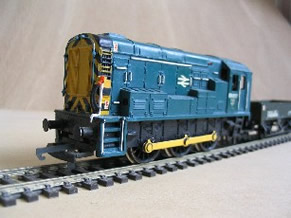
|
|
Class 09 / D3665 - D3671, D3719 - D3721, D4099 - D4114 - BR / English Electric 350hp 0-6-0 Diesel Electric Shunter No. 09-007 in BR blue livery with black and yellow 'wasp' ends from two photographs taken by me at the Stewarts Lane depot open day on the 10th April 1988. A detailed Lima model with 30 wire handrails. Southern Region high level brake pipes cast in whitemetal from a conversion kit are fitted as are SR high level marker lights made from plastikard. 'Cables' are from thin plastic rod. The original hinges on the bonnet side doors are replaced with shorter ones. Sprung buffers are fitted. Howes Railmatch and Humbrol paints were used. Transfers are PC 'Pressfix'. The class 08s were delivered from 1952, based on various earlier designs for the 'big four' railways. This locomotive was delivered from BR Darlington Works in 1959. The 26 class 09s were built as standard class 08s from 1955 to 1957 at Darlington Works. Starting in 1959, they were modified for the Southern Region and regeared to raise their top speed from 15 to 27.5mph and reclassified class 09.
Back to Top
|
| |
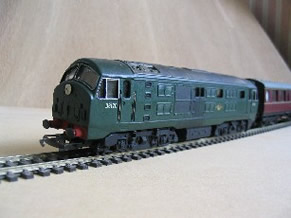
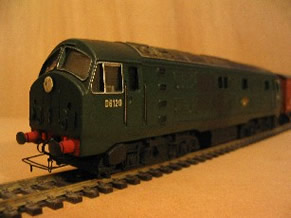
Photo is BRMLD P.80.
|
|
Class 21 / D6100 - D6157 - North British Locomotive Company / MAN 1,100hp Type 2 Bo-Bo Diesel Electric No. D6120 in original, unrebuilt condition in green livery with no yellow warning panels from a photograph taken on 2nd May 1963. A modified and detailed Hornby model. Lima disc headcodes are fitted as the D6100s only received headcode boxes when they were rebuilt as Class 29s. The end lights have been modified from the original Hornby model. The central side radiator grilles have been removed and replaced with the large mesh grille fitted to the production series locomotives. Extra handrails, grilles and inspection / filler hatches have been added to the roof. The raised panel edges have been replaced with scored-in ones and the exaggerated rivet detail has been removed. The windscreen pillars have been thinned down and the area of the frames removed has been replaced with plastic strip. The Hornby glazing is retained. Weathering is a combination of a black wash, with black dry-brushing on the roof. Paint is Howes Railmatch and Humbrol and transfers are PC 'Pressfix'. This class was one of very few mainline diesel locomotive classes on BR to have spoked wheels, along with the North British class 22s and D600 'Warships' the class 22s were based on. First introduced in 1958, the first 38 of the 58 class 21s were delivered to the Eastern Region and the last 20 to the Scottish Region. The class proved highly unreliable and were eventually all transferred to Scotland to be nearer the manufacturer. In early 1963 D6123 was sent for rebuilding by Davey Paxman at Colchester and was fitted with a 1,350hp Paxman 'Ventura' engine. A further 19 locomotives were rebuilt and all 20 were painted in two-tone green and reclassified class 29. The original class 21s were withdrawn in 1968 and the class 29s in 1971. All the locomotives were broken up for scrap.
Back to Top
|
| |
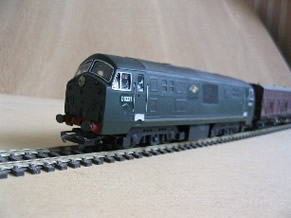
|
|
Class 22 / D6300 - D6357 - North British Locomotive Company / MAN 'Baby Warship' 1,100hp Type 2 B-B Diesel Hydraulic No. D6331 in original green livery with disc headcodes and no yellow warning panels, from a photo taken in June 1961. This is a Silver Fox Models resin body on a scratchbuilt .060" plastikard chassis. The power bogie is Hornby and the pickup bogie is scratchbuilt from plastikard with Romford / Jackson 14mm spoked locomotive wheels modified so that one side is 'live'. Bogie sideframes are white metal, by Modern Traction Kits as I felt they were both heavier and slightly more accurate than the resin ones supplied. Transfers are PC 'Pressfix' and Paint is Howes Railmatch or Humbrol enamel. Weathering was done by painting all grilles black, giving the whole loco body a black wash and very carefully spraying above the roof with matt black Humbrol spray enamel to give a diffused, black exhaust effect. D6300s were apparently prone to 'boiling over' when hot and, accordingly, a localised, white 'wash' was applied around the radiator fan grille as per the prototype. Finally, the model was sprayed with Humbrol matt varnish before the glazing was fitted. Glazing is from the Silver Fox kit on the end windows and using Microscale 'Micro Kristal Klear' on the side windows as those supplied do not seem to fit very well. The class 22s were introduced from 1959 and were all withdrawn for scrap between 1968 and 1971. Locomotives from D6335 were fitted with roller blind headcodes from new, with many earlier locomotives being fitted later on. This locomotive went into traffic in July 1960 at Plymouth Laira and was one of the last of its class withdrawn, from Bristol in March 1971, still in green livery, but with yellow warning panels and headcode boxes.
Back to Top
|
| |
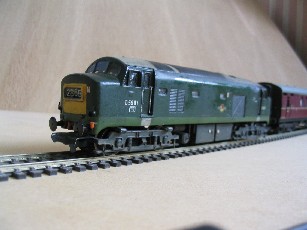
Photos are BRMLD P.89 and 25YoR P.78.
|
|
Class 23 / D5900 - D5909 - English Electric / Napier 'Baby Deltic' 1,100hp Type 2 Bo-Bo Diesel Electric No. D5901 in rebuilt condition in green livery with headcode boxes and a small yellow warning panel, from photos from the sixties and seventies. This is the now unavailable (although there is a new version) DC Kits white metal body, soldered together with great difficulty and on a scratchbuilt .060" plastikard chassis with the supplied white metal fuel tanks. The power bogie is Hornby and the pickup bogie is scratchbuilt from plastikard with Lima wheels. Both bogies have the DC Kits sideframes. Transfers are PC 'Pressfix'. Paint is Howes Railmatch or Humbrol enamel. Weathering was done by painting some of the grilles black and giving the whole loco a black wash. The underframe was 'dry-brushed' with Humbrol BR freight bauxite. Glazing is Microscale 'Micro Kristal Klear'. The class 23s were the least successful of any EE designs, having a single Deltic engine in a body design scaled down from the class 40. They were all built at Vulcan Foundry. The first locomotive had to be modified before it was delivered in 1959 as it was over the required weight. When delivered, the locomotives were still overweight and could not work on all the planned routes. After engine problems, the whole fleet was taken out of service by 1963 and sent for rebuilding at Vulcan Foundry. All the rebuilt locomotives were back in service in mid 1965 and sported a revised green livery with small yellow ends and new roller blind headcode boxes. All locomotives were withdrawn from capital stock as non-standard between September 1968 and March 1971. This locomotive was unusual in that it outlived its fellow class members as it was used by BR Research until 1975 in the condition modelled, until it was cut up in 1976.
Back to Top
|
| |
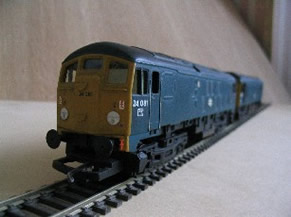
|
|
Class 24/1 / D5050 - D5150 - BR / Sulzer 1,160hp Type 2 Bo-Bo Diesel Electric No. 24-081 in final BR blue livery with full yellow ends and plated-over end communicating doors, but original disc headcodes, from photographs taken on the 4th of March 1978 and in February 1980. A Silver Fox Models resin body on a lowered Hornby Class 25 chassis and bogies. The lower body skirts are cut away to represent the locomotive in its final condition. The lower body ends are remodelled with filler and Cav'n'dish turned brass buffers are fitted. The fuel tank area is scratchbuilt from plastikard and modelled without the steam heating water tank. There are extra hatches in the roof for the steam heating water fillers and the bodyside steps are plated over as BR did to prevent electric shocks to staff from overhead wires. The body ends have been modified to fit over the redundant body clips on the Hornby chassis, in order to hold the body on. The Hornby glazing is retained. Weathering is an all over black wash with black spray over the roof. Paint is Howes Railmatch and Humbrol and transfers are PC 'Pressfix'. The prototype of this locomotive was built as number D5081 at BR Derby Works in March 1960. It out-lasted its fellow class members by 18 months, with the exception of 24-061 which was taken into Departmental service in 1975, being withdrawn from Crewe depot in October 1980. This locomotive is currently preserved at the Gloucestershire Warwickshire Railway, Toddington.
Back to Top
|
| |
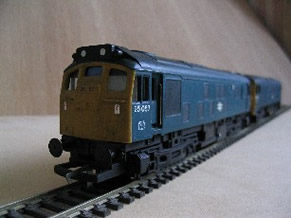
|
|
Class 25/1 / D5176 - D5232 - BR / Sulzer 1,250hp Type 2 Bo-Bo Diesel Electric No. 25-057 in final BR blue livery with full yellow ends and plated-over end doors, circa 1980s, partly from a photograph taken on 21st August 1980. A detailed and lowered Hornby model. Bodyside steps are plated over, as are the second largest bodyside grilles. Cav'n'dish turned brass buffers are fitted. Weathering is an all over black wash and a black spray over the roof. The Hornby glazing is retained. Paint is Howes Railmatch and Humbrol and transfers are PC 'Pressfix'. The class 25s were based on the earlier class 24s, but with an uprated 'B' series power unit. The 25/1s had their horns mounted at roof level, rather than at the buffer beam like the 24s and 25/0s. They also had a new underframe and roof layout compared to the 25/0s. The prototype locomotive was delivered from BR Derby Works in 1963 as D5207, was withdrawn on the last day of the class, from Crewe Diesel Depot on 15th March 1987 and is now preserved.
Back to Top
|
| |
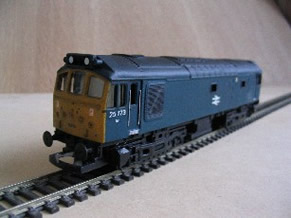
|
|
Class 25/2 / D5233 - D5299, D7500 - D7567 - BR / Sulzer 1,250hp Type 2 Bo-Bo Diesel Electric No. 25-173 in final BR blue livery with full yellow ends, circa 1987, from photographs taken by me after its withdrawal at Vic Berry's scrapyard in Leicester on the 13th of January 1989 and at Leicester Depot on the 27th of April 1989. A lowered Hornby model with a Silver Fox Models resin body. The body and underframe have been detailed, wire handrails added to the body ends and the steam heating tank removed. Bodyside steps are plated over with plastikard. The Hornby glazing is retained unless this locomotive is being used as a camera loco, as 25/2s have large central end windows ideal for this purpose. The engine room windows are glazed with Kristal Klear. The brown area on the roof, now difficult to see after weathering, is to emulate the unpainted fibreglass roof panels on this locomotive. Railwayania turned brass, large-headed buffers are fitted. Paint is by Howes Railmatch and Humbrol. The weathering was done by painting small 'rust' patches on the ends with Howes GWR coach chocolate paint, an overall black wash and then a matt black spray above the roof. Transfers are by PC, Replica, Woodhead and Railmatch. Most of the 25/2s and all the 25/3s had all 3 end windows the same height as a result of not being fitted with the little-used end communicating doors of earlier locos. They also had many of the bodyside louvres moved to shoulder level, tidying up the bodyside appearance. This was with the exception of 25/2s D7568 - D7597 ( 25-218 to 25-247 ), as produced by Hornby, which retained the earlier body style as they were built at BR Darlington Works. The prototype for this model entered service in 1965 from BR Derby Works as D7523 and, like 25-057, was withdrawn from Crewe Diesel Depot on 15th March 1987. It is now owned by Dr. John F. Kennedy, after whom it has been named. There are other photographs on the derbysulzers and martinbray websites.
Back to Top
|
| |
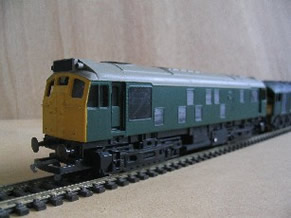
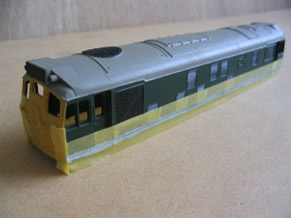
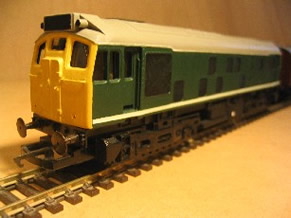
|
|
Class 25/2 / D7568 - D7597 - BR / Sulzer 1,250hp Type 2 Bo-Bo Diesel Electric No. D7577 in green livery circa 1971 with full yellow ends, unsealed end doors, unplated bodyside steps and steam heat, from photographs taken around the early 1970s. This is another lowered and detailed Hornby model with Railwayania large-headed buffers, wire handrails and a motorised Hurst Models etched brass fan and fan grille. The motor bogie had to be swapped to the other end of the model to leave space for the fan motor - an easy job on a Hornby locomotive - the chassis stretcher on the pickup bogie end just needed to be sawn away. The Hornby glazing is retained. After painting, the body grilles were painted black, then the body was given a heavy black wash and a matt black spray over the roof. Paint is by Howes and Humbrol and all transfers are by Fox. This locomotive was delivered from BR Derby Works in 1963 as part of the only batch of 30 class 25/2s with the original body style. It moved to Cricklewood Depot in October 1964. The locomotive was one of the class 25s that was transferred from the Midland Region to Plymouth Laira Depot on the Western in October 1971 to help replace the class 22 diesel hydraulics on light duties in Devon and Cornwall. It had moved to Eastfield Depot in Glasgow by 1979, moving to Haymarket around 1982, but returned to the London Midland Region at Crewe Diesel Depot from Haymarket on 3rd October 1982. During its life it was fitted with train air brakes in addition to the original vacuum brakes. It was withdrawn from Crewe in June 1983 and cut up at BR Swindon Works in December 1983. Photos are BRDDH P.25 and DoCML P.85. There is a photograph taken when it had half yellow ends in 1967 on the 53a website and as 7577 in blue with full yellow ends in 1973 on BRMLD P.102. It is also photographed after renumbering as 25-227 on P.38 of BRDM1 on 24th July 1975 and on P.130 of RMag on the 13th November 1982. This model is currently awaiting underframe weathering.
Back to Top |
| |
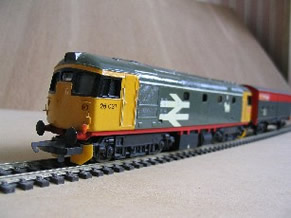
Photograph is BRL87 centre pages.
|
|
Class 26 / D5300 - D5346 - Birmingham Railway Carriage & Wagon / Sulzer 1,160hp Type 2 Bo-Bo Diesel Electric No. 26-031 in Railfreight grey livery from a photograph taken on the 11th May 1986. A conversion from a Lima Class 33. All conversion work was done with plastikard, Plastruct sections, wire and filler. This locomotive entered service in 1959. The model needs updating and weathering.
Back to Top
|
| |
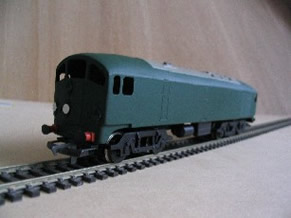
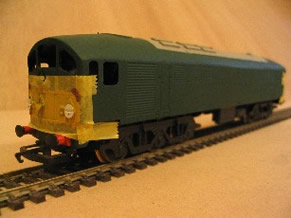
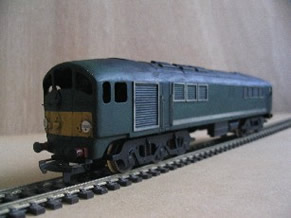
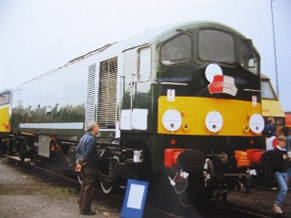
|
|
Class 28 / D5700 - D5719 - Metropolitan Vickers / Crossley 1,200hp Type 2 Co-Bo Diesel Electric No. D57 in green livery. The Q Kits model - white metal with etched brass sides, soldered together with much difficulty and quite a lot of filler. The underframe is a reinforced sheet of .060" plastikard and a combination of the Q Kits etched battery boxes and scratchbuilding. The power bogie is from a Lima Class 52 in the 'Co' end with an extra pickup and the pickup bogie is scratchbuilt from plastikard with Hornby wheels. Bogie sideframes are scratchbuilt from plastikard as the etched ones in the kit were missing the mainframes. Body details are super-glued on. Paint is Howes Railmatch and Humbrol. This model is currently being painted.
Back to Top
|
| |
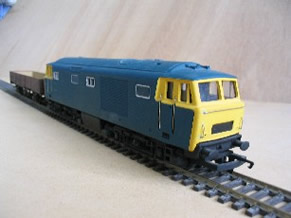
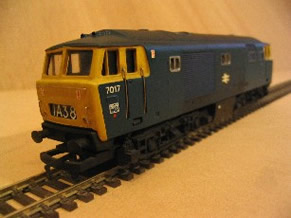
Photos are BRDDH P.58, DW P.20 and MRP8 P.31.
|
|
Class 35 / D7000 - D7100 - Beyer Peacock / Maybach 1,740hp Type 3 B-B Diesel Hydraulic No. 7017 in final BR blue livery with full yellow ends, circa 1973. A Hornby model, lowered and detailed. Extra exhaust ports are cut into the roof and wire handrails fitted. The headcode boxes are modified as one used to hold one end of the body onto the chassis. The original Hornby 40 gramme steel weight has been replaced with nearly 150 grammes of roofing lead, carefully fitted into the centre of the underframe. This locomotive went into traffic in January 1962 at Bristol and was one of the last of its type to be withdrawn, in March 1975 from Old Oak Common Depot in London, and is preserved by the Diesel Traction Group at the West Somerset Railway. This model is currently being painted.
Back to Top
|
| |
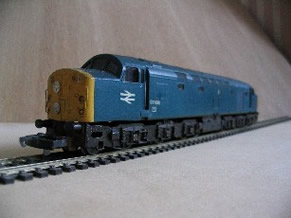
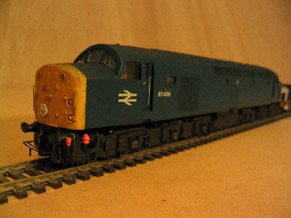
|
|
Class 40 / D200 - D399 - English Electric 2,000hp Type 4 1Co-Co1 Diesel Electric No. 97-408 (formerly D318 and 40-118) in final BR blue livery from photographs I took at the Birmingham Railway Museum on the 18th December 1988. A detailed Lima model with wire handrails. The original Lima paint is mostly undisturbed, but weathering is a heavy black wash, a black spray over the roof and a dry-brush of BR bauxite over the underframe area. Front and rear lights are fitted in the direction of travel. Transfers are PC 'Pressfix'. The numbers are deliberately applied 'badly' to mimic the real locomotive. The prototype for this locomotive is preserved at the Birmingham Railway Museum, Tyseley and was used in the famous 1967 film 'Robbery' to deputise for the class 40 involved in the 'Great Train Robbery'. During 1984 - 1985, several temporarily reprieved Class 40s, including 40-118, were used on engineers' trains for Crewe remodelling work, numbered in the 97/4 series. This locomotive was part of the small batch ( D305 - D324 ) that was constructed by Robert Stephenson & Hawthorn of Darlington, all others were constructed by Vulcan Foundry.
Back to Top
|
| |
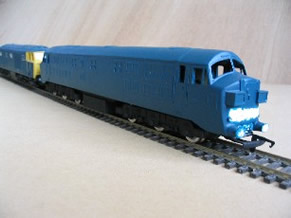
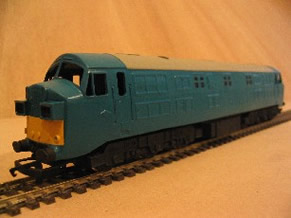
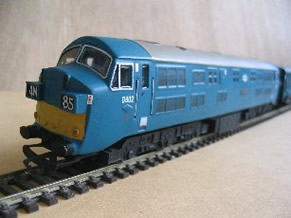
Photos are BRFS2 P.15, MR39 P.40 and on the railblue.com website.
|
|
Class 41 / D600 - D604 - North British / MAN 'Warship' 2,000hp Type 4 A1A-A1A Diesel Hydraulic No. D602 'BULLDOG' in BR 'chromatic' blue livery with central BR logos, roller blind headcodes and small yellow warning panels, as repainted in 1967. This is the Silver Fox Models resin body on a scratchbuilt .060" plastikard 'bathtub' chassis with scratchbuilt battery boxes and 2 Hornby power bogies. Each bogie has one of the kit's white metal bogie sideframes on one side and one of the resin ones on the other, on opposite sides of the locomotive for even weight distribution. The underframe is sprayed with 2 coats of Humbrol matt black aerosol. The class 41s were introduced from January 1958 as the prototype large diesels for the Western Region and being a small class and rather unreliable, were all withdrawn from Plymouth on 30th December 1967. D602 was delivered to Plymouth Laira Depot in November 1958 and cut up in December 1968. This locomotive was one of two of the class of five to receive blue livery, the other being D600 which was painted in rail blue with full yellow ends and a BR logo on each cabside. This model is currently being painted with Howes' BR rail blue paint mixed with Humbrol satin white, with the engine room roof being painted with Howes BR diesel roof grey. This is my best guess of the correct colour scheme as it appears in the photographs.
Back to Top
|
| |

|
|
Class 42 / D800 - D832, D866 - D870 - BR Swindon / Maybach 'Warship' 2,200hp Type 4 B-B Diesel Hydraulic No. 825 'INTREPID' in BR blue livery with mostly yellow ends, from a photograph taken on the 6th June 1971. This is a modified and repainted Lima model. The underframe skirt on one side has been changed to match the prototype as the Lima version has both sides the same. The central shoulder-level vent in one side has been filled over as it is also not present on the prototype. An extra exhaust port has been cut into the roof for (presumably) the steam heat boiler and the paint around this scraped away to create the 'scorched' effect present on many Warships. The nose ends have been detailed and fitted with wire handrails. Etched brass nameplates are fitted. Paint is Howes Railmatch and Humbrol and transfers are PC 'Pressfix'. Weathering is an all-over black wash with black dry-brushing. There is extra weathering on the ends and roof as these got particularly dirty on Warships. One of the main side grilles on each side has extra weathering to mimic the effect of water and dirt as this grille houses the water filler for the train heating boiler. The 'D' prefix is missing from the number as BR removed 'D' prefixes on diesel locomotives and 'E' prefixes on electrics as the numbers no longer clashed after the end of steam in 1968. The Warships were based on the German V200 class diesel hydraulics and as such were the first BR-built diesels to have a stressed steel load-bearing body, rather than a separate girder chassis. This locomotive was delivered in August 1960 and withdrawn in August 1972. Photo is BRFS2 P.36.
Back to Top |
| |
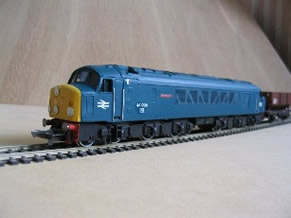
|
|
Class 44 / D1 - D10 - BR Derby / Sulzer 'Peak' 2,300hp Type 4 1Co-Co1 Diesel Electric No. 44-008 'Penyghent' in final BR blue livery with yellow ends and sealed end corridors, but original disc headcodes, circa 1979. This is a converted Mainline Class 45, using the Craftsman kit. Bodyside steps are plated over. Both noses have been raised to match the prototype and the bogies are modified to incorporate the buffer beams, mostly using the parts from the kit. Sprung buffers are fitted. The train air brake tanks have been removed from the underframe as the class 44s were latterly mainly used on unfitted goods trains. Etched brass nameplates are fitted. The ten class 44s were prototypes for the later production runs of class 45s and 46s, the main external difference being that the class 44s had disc headcodes. The class was inroduced from 1959, the last one being withdrawn in 1980.
Back to Top |
| |
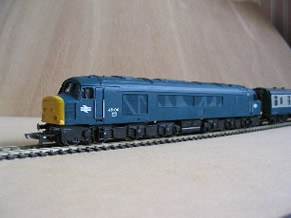
|
|
Class 45/0 / D11 - D137 - BR Derby & Crewe / Sulzer 'Peak' 2,500hp Type 4 1Co-Co1 Diesel Electric No. 45-041 (formerly 'Royal Tank Regiment') in final BR blue livery with plated-over headcodes, yellow ends and marker lights, from a photograph taken on the 29th August 1985. A Bachmann Class 46 body on a Mainline Class 45 chassis, simply because I had the two parts spare. The bufferbeams have been built onto the bogies with plastikard and sprung buffers are fitted. An extra hatch is cut into one body side as per the prototype. The two smaller bodyside grilles are plated over with thin plastikard, pressed from the back to simulate bolts. Paint is the original Bachmann with Howes Railmatch blended in around the new hatch and Humbrol. Transfers are PC 'Pressfix'. The class 45s were introduced from 1960, the last one being withdrawn in 1988. This locomotive entered service in 1962 and was built at BR Crewe Works. Photo is BRL87 centre pages.
Back to Top |
| |
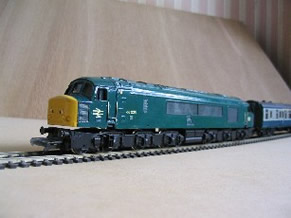
|
|
Class 46 / D138 - D193 - BR Derby / Sulzer 'Peak' 2,500hp Type 4 1Co-Co1 Diesel Electric No. 46-035 in final BR blue livery circa early 1980s. A Mainline class 45 modified with filler and plastikard to have its buffer beams on the bogies and plated over steam heat water fillers. An extra grille is added to each side, cast in Milliput. Wire handrails are fitted. Paint is by Humbrol, including a dubious shade of rail blue. Transfers are PC 'Pressfix'. The prototype was used by BR Reasearch for traction experiments after it was withdrawn from revenue service and has now been brought back into use on the mainline by its owner, Pete Waterman as D172 'Ixion'. This is an old model in need of some improvement. The 56 class 46s were almost identical to the class 45s, except that they used Brush generators and traction motors, rather than Crompton Parkinson. The last 20 of the 76 ordered were never built, their electrical equipment being built into the first 20 class 47s. The first class 46 was introduced in 1961 and the last was withdrawn in 1984.
Back to Top |
| |
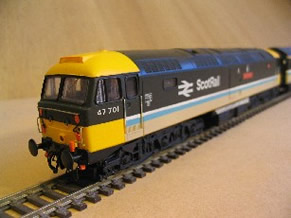
|
|
Class 47/7 - BR / Sulzer 2,580hp Type 4 Co-Co Diesel Electric No. 47701 ‘Saint Andrew’ (ex 47-493) in late 1980s ScotRail livery, partly from a photograph taken by me at Glasgow Queen Street in 1987.
The Model
This is the excellent Lima model, which was one of the best ready-to-run locomotives when it was released about 15 years ago and has very few shortcomings when compared to more recent models, except that newer models are smoother-running and more powerful, although much more expensive. Having said that, there is always room for improvement on any r-t-r model. General detailing ahs been carried out, although this is mainly restricted to the ends, which have wire handrails, etched brass multiple working cable attachments and white metal train heating jumper cables from a Craftsman class 86 electric locomotive detailing kit. Various other small details are made from Plastikard and wire, including the white, coiled coolant pipe on one side of the chassis which was bent up from handrail wire and was a very fiddly job. The Lima coupling at the 'outer' end has been removed, allowing the fitting of brake pipes and a dummy screw coupling. The 'inner' end coupling is retained. An extra electrical pickup is fitted to each bogie and directional front and rear lights are fitted. The moulded guard irons on the bogies were cut off and moved inwards, in line with the wheels. The original Lima glazing and paintwork is retained with some touch-ups and yellow ends added. The white bodyside stripe was missing originally, so this was painted on. Weathering was a black wash all over with dry-brushed black on the cab roofs. This model awaits a few minor details and chassis weathering.
Back to Top |
| |
The 47/7s
Between 1962 and 1966, the Brush Falcon Works in Loughborough and British Railways Crewe Works produced 512 class 47s after an initial order for 20 using the electrical equipment from the cancelled last 20 class 46s. They weighed between 111 and 121 tonnes, depending on installed equipment, and were 63 feet 6 inches long. The 47s were to become the standard, large, mixed-traffic diesel locomotives of BR and were by far the most numerous type of mainline locomotive in this country for 20 years. The original BR shuttle trains on the Glasgow to Edinburgh route were the class 126 DMUs introduced in 1957, but by the late 1960s it was decided that they needed improvement or replacement. In 1971, modified class 27s started to be used at both ends of sets of coaches on the shuttles, although other locomotives could be used, such as class 25s. In 1979, twelve and later in 1984 four more class 47/7s were converted from standard electric-heat class 47/4s to work between Glasgow Queen Street and Edinburgh Waverley in push-pull mode with semi-permanently coupled sets of five Mark 3 coaches, although other vehicles could be substituted. The standard locomotives are limited to 95mph, but the 47/7s are allowed a top speed of 100mph and weigh 119 tonnes. The locomotives had a headlight fitted and a remote control system was installed called Time Division Multiplexing (TDM), which used standard Railway Clearing House (RCH) train heating cables and digital electronics to control one end of the train from the other. A converted Mark 2e Brake Second Open coach was coupled at the other end of the train with a driving cab added at the brake van end and newly designated a Driving Brake Second Open (DBSO). After the ScotRail brand was introduced in September 1983, all the 47/7s and the dedicated coaches were repainted into that livery. Perhaps some railwaymen are superstitious, as after 47-713 was written-off in an accident, its converted replacement was given the number 47-717. Further 47/4s were later converted into 47/7s with push-pull jumpers for use in parcels trains, a traffic now mostly lost to rail. 47/7's were replaced on the Glasgow to Edinburgh services by class 158 Diesel Multiple Units (DMUs), but today this service is operated by class 170 Diesel Multiple Units (DMUs). The vast majority of the original 512 class 47s has been withdrawn, although many are still running on the mainline and in preservation and several of the 'original' 47/7s are still intact, some in full working order and passed for mainline operation. 47-701, 703, 709, 712 and 715 are operational, 47-705 is operational, but has been re-engined with a second hand General Motors unit and renumbered as class 57 number 57-303. 47-707, 714 and 716 are stored and the remainder have been scrapped.
47-701
This locomotive was delivered from BR Crewe Works in 1966 and gained the Total Operations Processing System (TOPS) number 47-493 after 1972, keeping it until conversion to 47-701 in 1979. Following the sectorisation of BR in the mid 1980s, the 47/7s were painted into the then new ScotRail livery. From the late 1980s, they were all gradually transferred away from their dedicated route as they were replaced by DMUs. Some locomotives, including 47-701, which was transferred to West London's Old Oak Common Depot in November 1990, were used along with class 50s on the London Waterloo to Exeter route, although drivers found the slight extra power of the class 50s helped to keep time better. 47-701 was painted in revised Network SouthEast livery and was renamed 'Old Oak Common Traction and Rolling Stock Depot' on 18th August 1991, carrying the name until June 1993. Various liveries have been worn by the fleet since their transfer away from their Glasgow - Edinburgh duties. The locomotive was transferred to Crewe Depot for parcels duties in August 1993 and was stored in April 1997. 47-701 was purchased privately by Alan and Tracey Lear in 1997, returned to mainline service under the Fragonset Rail safety case in FR black livery and was renamed 'Waverley' at Crewe International Electric Maintenance Depot in 1997. It was hired for passenger trains by Virgin Cross Country and for goods by Freightliner until being withdrawn again in 2003. The locomotive was stored at MoD Ludgershall and then at MoD Long Marston where it was hired by Cargo-D to heat their rake of Mark 3 coaches which has since moved to Crewe. 47-701 ran at the Gloucestershire Warwickshire Railway in summer 2008, still in then rather tatty FR black and although in working order, it cannot be returned to the mainline until Train Protection and Warning System (TPWS) is fitted.
Photographs
| Livery |
Ref. |
Source |
Date |
| BlY |
Pl.236 |
Prot47s |
c. 1979 |
| BlY |
Pl.237 |
Prot47s |
c. 1979 |
| BlY |
Pl.238 |
Prot47s |
25th Feb 1979 |
| BlY |
P.43 |
BRNotB |
13th April 1979 |
| BlY |
Pl.135 |
BROit80s |
25th Jan 1980 |
| BlY |
P.91 |
MPR1 |
pre-1981 |
| BlY |
P.68 |
BRNotB |
4th Sept 1982 |
| ScR |
8/54/12 |
My photo |
13th Aug 1987 |
| ScR |
P.16 |
RE117 |
20th Jan 1990 |
| NSE(R) |
P.23 |
LSWRT&N |
14th Aug 1992 |
| NSE(R) |
P.37 |
LSWRT&N |
16th Feb 1993 |
| NSE(R) |
P.78 |
LSWRT&N |
1st March 1993 |
| FR |
P.73 |
RE597 |
5th July 2008 |
| FR |
P.70 |
RE606 |
25th Oct 2008 |
|
| |
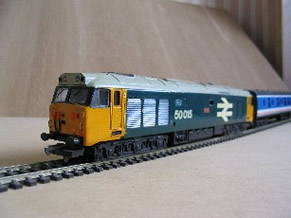
|
|
Class 50 / D400 - D449 - English Electric 2,700hp Type 4 Co-Co Diesel Electric No. 50-015 'Valiant' in BR revised, large-logo blue livery, circa mid to late 1980s. A detailed Lima model with wire handrails and etched brass nameplates. The original Lima paint is retained, but with Humbrol touch-ups. Small transfers are by Replica Railways. The main feature of this locomotive is a second power bogie, giving it 8 wheel drive with 4 traction tyres. This means it will pull almost any train, but it is rather noisy and unsophisticated. Two extra pickups are fitted - an easy job with wire and a soldering iron on 6 wheel Lima bogies. Headlights are fitted in the direction of travel and the headcode boxes have been modified to the plated over version, as per the prototype, and with clear polystyrene marker lights, allowing lighting at a later date. The end sandboxes are covered over and a window on each bodyside has been replaced with a louvre as on the real locomotives after they were rebuilt. Etched nickel silver nameplates are fitted. The 50 class 50s were all built at Vulcan Foundry, Newton-Le-Willows and were introduced onto the West Coast Mainline from 1967, in blue livery, to help accelerate passenger train timings while electrification was incomplete, often running in pairs. Once ousted from the West Coast by the class 87 electrics, they were transferred to the Western Region, where they were given 'Warship' names and helped to replace diesel hydraulics. They underwent rebuilding as passenger-only locomotives at BR Doncaster Works in the early 1980s, partly in the hope of improving their reliability. This locomotive entered service in 1968. The model needs a little improving, especially some of the paintwork.
Back to Top |
| |
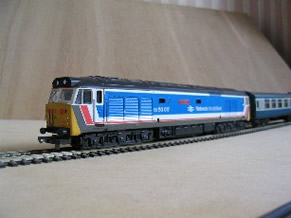
|
|
Class 50 / D400 - D449 - English Electric 2,700hp Type 4 Co-Co Diesel Electric No. 50-017 'Royal Oak' in early BR Network SouthEast livery, from photographs taken in 1986 and 1987. Another Lima model with detailed ends fitted with wire handrails and the end sandboxes covered over. Most of the original Lima paint is retained, but with Humbrol and Howes Railmatch touch-ups. Two extra pickups are fitted and etched nickel silver nameplates. Headcode boxes are changed to match the plated over type. Replica Railways 'orange square' multiple working code transfers are fitted. Lead is added for ballast. A few items on this locomotive still need to be finished off. This locomotive was delivered new as D417 from Vulcan Foundry on 6th April 1968 and moved to the Western Region in May 1974. It was repainted into this livery in early June 1986.
Back to Top |
| |
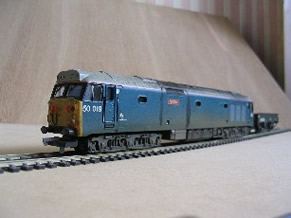
|
|
Class 50 / D400 - D449 - English Electric 2,700hp Type 4 Co-Co Diesel Electric No. 50-019 'Ramillies' in late BR blue Civil Engineer's livery, circa early 1990s. Yet another Lima '50', this model has detailed ends with wire handrails and the end sandboxes covered up. The cab roofs have radio domes scratchbuilt from plastikard. Headcode boxes have been changed to match the plated over type and have clear polystyrene marker lights to enable future lighting. Etched nickel silver nameplates and two extra pickups are fitted. The most obvious thing about this locomotive is its filthy appearance. This was copied from photographs of the locomotive after it had presumably suffered from lack of cleaning and an oil leak or spillage. The lower body and chassis are airbrushed with thinned 'track colour' paint. The roof is airbrushed with thinned matt black paint. The oil spillage on one side is carefully brushed, thinned matt black, with a similar treatment given to the fuel tank. The ends have a black wash. Paint is Howes Railmatch and Humbrol. Lead is added for ballast. Transfers are PC 'Pressfix', Replica Railways and FMR for the cantrail level orange stripe, except for the cab gutters which are handpainted with Humbrol paint. This locomotive entered service in 1968.
Back to Top |
| |
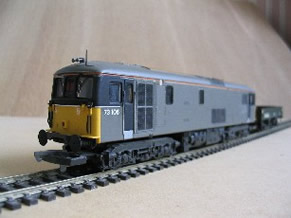
|
|
Class 73/1 / JB / E6007 - E6049 - BR Eastleigh / English Electric 3,150hp (electric) / 600hp (diesel) DC Electric / Diesel-Electric (Electro-Diesel) No. 73-106 in BR Departmental grey livery. A Detailed Lima model. Grilles are painted black, a light black wash is applied and there is black dry-brushing around the exhaust. Radio aerials are fitted. The underframe was lightly drybrushed with BR bauxite. Cav'n'dish turned brass buffers and DC Kits headlights are fitted. Paint is Howes Railmatch and Humbrol. Transfers are PC 'Pressfix' with FMR orange overhead wire warning lines. This locomotive was built at Vulcan Foundry, Newton-Le-Willows in 1966.
Back to Top |
| |
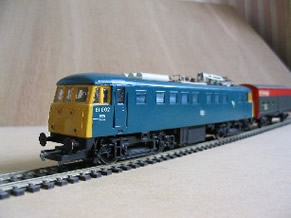
|
|
Class 81 / AL1 / E3001 - E3022, E3096 / E3097 - Birmingham Railway Carriage And Wagon 4,800hp AC Electric No. 81-002 in its final BR blue livery, circa late 1980s. A Lilliput body bought for a few pounds several years ago from Dapol. It has a scratchbuilt plastikard chassis with the Hornby Class 86 bogies left over from the conversion of 86-103 ( see later – waste not, want not ). The centres of the Hornby bogie sideframes are cut out to make them look more like a Class 81's. The original Lilliput model ( no longer available ) had scale length bogies, if rather basic, but the bogie centres are wrong, so the cosmetic bodyside bogie hangers were moved. The headcodes are converted to the later plated-over type with marker lights. Wire handrails and Cav'n'dish turned brass buffers are fitted. The bus bars, wiring and insulators on the roof are soldered up from scratch using various sizes of brass tube cut into thin sections and wire. The roof-mounted tanks are unpainted aluminium tube with Milliput filler to create the rounded ends. The pantograph is Hornby. Etched nickel silver 'double arrow' logos are fitted. Transfers are PC 'Pressfix' with Glasgow Shields depot's 'salmon' emblems by Replica Railways. Paint is by Howes Railmatch and Humbrol. The model is unweathered. The Class 81s were one of the first 5 AC electric designs for the West Coast and lasted the second longest after the 85s (or AL5s). This locomotive was built by BRC & W Co. in Smethwick in 1960.
Back to Top |
| |
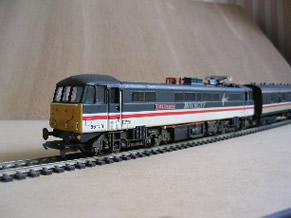
|
|
Class 86/1 / E3191, E3150 & E3143 - English Electric / BR 7,860hp AC Electric No. 86-103 'André Chapelon' in its final BR Inter City 'Swallow' livery, circa late 1990s. A modified and detailed Hornby model. The underframe has been modified to match the prototype's similarity with a class 87, but the major conversion work was to fit Hornby Class 90 bogies. This involved grinding away the back of the cast steel cab interiors to get the extra space required for the longer, scale-length bogies. The underframe also had to be slightly cut back to fit. The Hornby Class 86 bogies are a reasonable model of the originals, but far too short. The ends have been detailed and fitted with wire handrails. The stripes on the Time Division Multiplexing ( multiple working ) plugs are handpainted. Etched nickel silver BR 'barbed wire' ( or 'double arrow' ) logos are fitted and DC Kits headlights. Etched brass nameplates and Cav'n'dish turned brass buffers are fitted. Extra cab door handles are fitted lower down as on the real locomotive. The model is in near-clean condition, with a light dry-brushing of BR bauxite over the underframe. The paint is by Howes Railmatch and Humbrol. The transfers are mostly by FMR, including the bodyside stripes. The 86s were based on the very successful Class 85s. The three Class 86/1s were used as a test bed for the later Class 87s, employing their control gear and bogies and were all named after locomotive engineers. In turn, the Class 90s were based on the solitary Class 87/1 number 87-101 and were originally going to be designated Class 87/2. This locomotive was built at Vulcan Foundry, Newton-Le-Willows in 1966 and rebuilt with class 87 BP9 bogies by BR Crewe Works. 86-103 was the first of the non-standard 86/1 sub-class to be withdrawn and was broken up around the end of 2003.
Back to Top |
| |
Loco Descriptions - Livery Codes
| BlaNoY |
BR shunter black livery without yellow ends. |
| BlaY |
BR shunter black livery with yellow or yellow and black 'wasp' ends. |
| BGNoY |
BR brunswick locomotive green livery without yellow ends, with or without bodyside stripes.
|
| BGy |
BR brunswick locomotive green livery with small yellow ends, with or without bodyside stripes.
|
| BGY |
BR brunswick locomotive green livery with full yellow ends, with or without bodyside stripes. |
| Bl |
BR monastic or rail blue with full yellow ends. |
| BlSil |
BR monastic or rail blue with full yellow ends and a silver roof. |
| Bly |
BR monastic, rail or chromatic blue with small yellow ends. |
| BlY |
BR monastic or rail blue with full yellow ends. |
| BBl |
BR monastic or rail blue with yellow cabs, grey or black roof and large logo and numbers. |
| Deptl |
BR Departmental mid-grey livery with full yellow ends and black cab window surrounds. |
| Ex(R) |
BR Inter City Executive (Revised) livery with black roof and top halves of sides, light grey lower sides, a red and white central stripe and full yellow ends. |
| FR |
Fragonset Rail blackberry black with full yellow ends. |
| GrtWes |
GWR green livery with the words 'GREAT WESTERN' on the tank or tender sides, with or without a company crest. |
| GW |
GWR green livery with the letters 'GW' on the tender sides with a company crest in between. |
| GWR |
GWR green livery with the letters 'GWR' on the tank or tender sides. |
| NSE |
BR Network SouthEast livery with a broad mid blue stripe and small, mid-grey and red bottom stripes on a white background with full yellow ends. |
| NSE(R) |
BR Network SouthEast (Revised) livery with a broad darker blue stripe and small, dark-grey and red bottom stripes on a white background with full yellow ends. |
| RF |
BR Railfreight livery with mid-grey body, large logo, yellow cabs, black cab window surrounds and red bufferbeams. |
| ScR |
BR ScotRail livery with black roof and top halves of sides, light grey lower sides, a light blue and white central stripe and full yellow ends. |
N.B.
In all cases, underframes are generally black. Various (usually minor) livery differences occur between different locomotives described as being in the same livery. |
| |
| 25YoR |
25 Years of Railway Research by Colin J. Marsden - OPC |
| BRDDH |
BR Diesels Double Headed by G. Weekes - Bradford Barton |
| BRFS2 |
British Rail Fleet Survey 2: Western Region Diesel Hydraulics by Brian Haresnape - Ian Allan |
| BRL87 |
British Rail Locomotives 1987 edited by Roger Wood - Ian Allan |
| BRMLD |
British Rail Main Line Diesel Locomotives by Colin J. Marsden and Graham B. Fenn - OPC |
| DW |
Diesels West by G. F. Gillham - Bradford Barton |
| MR39 |
Model Rail Magazine No. 39 - January 2002, edited by Chris Leigh - Emap Active Ltd |
| MRP8 |
Modern Railways Profile 8: The Hymeks by Colin J. Marsden - Ian Allen |
| PRotDS |
A Pictorial Record of the Diesel Shunter by Colin Marsden - OPC |
| TDS |
The Diesel Shunter by Colin J. Marsden - OPC |
www.derbysulzers.com
www.railblue.com
www.martinbray-ukloco.com
|
| |
Back to Top
|
|


|
|
